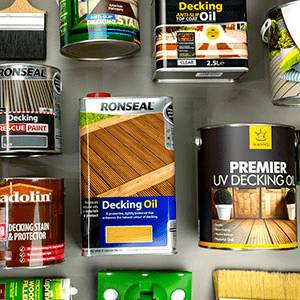Summerhouse Treatment FAQ's
Do I need to treat the inside of my summer-house?
This depends on what the summerhouse is being used for and how often it's being used. Although interior walls and floors can be left untreated, treating them can help to protect the wood, make cleaning far easier and add some colour and style to the interior of your summer house.
For floors, use a dedicated flooring product such as Ronseal Diamond Hard Floor Paint, Ronseal Diamond Hard Coloured Floor Varnish or for a clear finish, Manns Extra Tough Floor Varnish.
Hard Wax Oils such as Osmo Polyx Oil and Fiddes Hard Wax Oil will help to protect the natural wood of the floor from dust, dirt and grime whilst making it easier to clean. Walls and ceilings can also be painted, varnished or oiled if desired. It's worth noting that clear oils and varnishes on pine timbers will draw out the natural colour and grain of the wood. In some cases this can produce a fairly strong orange or yellow colouration to the wood. For this reason we always recommend trialling a test area before proceeding with the project.
Should I use a wood preservative on my summerhouse before painting?
Using an exterior wood preservative prior to painting will help to protect the wood from mould, algae and insect attack. When selecting a wood preserver however, be sure to pick one that is wax, oil and silicon free. Preservers that contain any of these elements may prevent or reduce the ability of the paint to bond with the surface of the summer-house. For this reason we always recommend doing a test area before starting any project.
Exterior wood preservers that contain wax or oil are fine to use if the summerhouse is going to be oiled rather than painted.
What should I paint my summer house with?
Wooden summerhouses can be treated with a variety of wood care products to protect, preserve and enhance the appearance of these outdoor structures. exterior wood paints can add colour whilst protecting the wood from weathering. An alternative to paint is a clear or coloured exterior wood varnish.
For larger summer-houses, our recommendation is to use an exterior wood oil such as Osmo UV Protection Oil Extra or Fiddes Exterior High Build Wood Oil. Wood oils help to keep the wood nourished and supple therefore helping to prevent cracking, splitting and warping of the summerhouse timbers. They are also easy to apply and maintain and will not crack, peel or flake off. Another great alternative is Barrettine Log Cabin Treatment.
Can I use a wood oil on the interior walls & floor of my summerhouse?
In a word, yes. Interior wood oils are durable, long lasting, easy to clean and easy to maintain and repair. This makes them ideal for use on summerhouse walls and floors to keep them protected.
I have green and black staining on my summerhouse. What can I do?
Green and black staining on the wood is usually a result of mould, mildew or fungi growth in and on the surface of the wood. Our recommendation is to clean the wood with a dedicated wood cleaner such as Barrettine Mould and Mildew Cleaner or other exterior wood cleaner, to remove and kill any biological growth on the wood. For heavy soiling, a second application of wood cleaner may be required. If there is a large physical build up of moss and mould, scrape off as much of the surface matter as possible before applying the wood cleaner.
If the summer house was previously untreated, we recommend that once thoroughly cleaned, the bare wood is treated with 2 coats of an exterior wood preservative such as Barrettine Premier Wood Preservative
or Ronseal Total Wood Preservative to protect from future infestations of mould and algae. Once dry, we recommend 2 coats of Barrettine Log Cabin Treatment for added weather protection.Summer House Treatments
- Summer House Preservatives
- Summer House Oils
- Summer House Stains
- Summer House Paints
- Other Summer House Treatments
Related Summer House blog posts
- How To Build A Summer House? Our Customer Shares His Experience.
- From Dingy Den To Craft Shed Heaven
Disclaimer: Whilst every attempt has been made to provide product information that is as accurate as possible, it's important to clarify that trees and the wood that they produce can be affected by many factors. For example, the same species of tree grown in the same wood, even in close proximity, will be affected by age along with the amount of sunlight and water they receive. Other naturally occurring biological and environmental factors will also influence the density and grain of the wood as well as the moisture and oil content of the timber. No two trees are the same, meaning each piece of wood has the potential to look and react differently to the same wood finish. For example, product adhesion, colour variations, absorption rates and sheen levels. It is for this reason that we always strongly recommend carrying out test areas before starting any project


